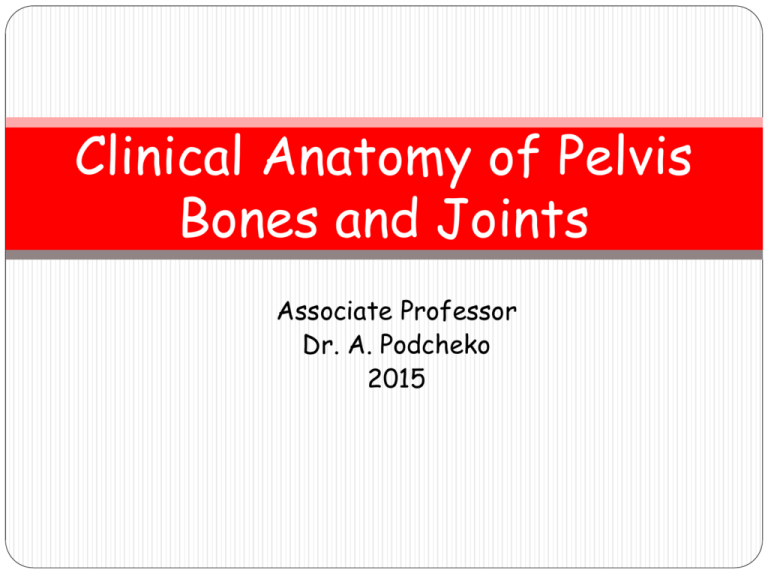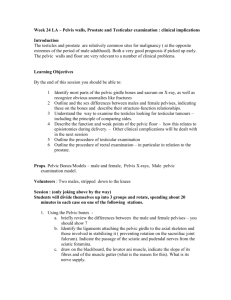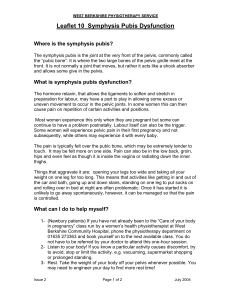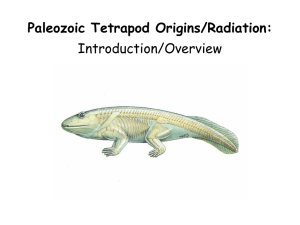Clinical Anatomy of Pelvis Bones and Joints
advertisement

Clinical Anatomy of Pelvis Bones and Joints Associate Professor Dr. A. Podcheko 2015 Pelvis: Definitions Pelvis is the part of the trunk infero-posterior to the abdomenthe area of transition between the trunk and the lower limbs Anatomically, the pelvis is the space or compartment surrounded by the pelvic girdle (bony pelvis), part of the appendicular skeleton of the lower limb pelvis is subdivided into greater and lesser pelves 2 Perineum: Definitions The perineum refers both to the area of the surface of the trunk between the thighs and the buttocks, extending from the coccyx to the pubis, and to the shallow compartment lying deep (superior) to this area and inferior to the pelvic diaphragm. The perineum includes the anus and external genitalia 3 Pelvis and Perineum: Functions The greater pelvis - protection to inferior abdominal viscera The lesser pelvis provides the skeletal framework for both the pelvic cavity and the perineum compartments of the trunk separated by the musculofascial pelvic diaphragm. Externally, the pelvis is covered or overlapped by the inferior anterolateral abdominal wall anteriorly, the gluteal region of the lower limb posterolaterally, and the perineum inferiorly. 4 Pelvic Diaphragm Pelvic bones & Pelvic Girdle: Functions The pelvic girdle is a basin-shaped ring of bones that connects the vertebral column to the two femurs. The primary functions of the pelvic girdle are to: 1. Bear the weight of the upper body (sitting and standing) 2. Transfer that weight from the axial to the lower appendicular skeleton 3. Provide attachment for the powerful muscles of locomotion and posture 5 Pelvic bones & Pelvic Girdle: Functions The secondary functions: 1. Contain and protect the pelvic viscera (parts of the urinary tracts and the internal reproductive organs) 2. Protect inferior abdominal viscera (intestines), while permitting passage of their terminal parts (and, in females, a full-term fetus) via the perineum 3. Provide support for the abdominopelvic viscera and gravid (pregnant) uterus 4. Provide attachment for the erectile bodies of the external genitalia 5. Provide attachment for the muscles and membranes which forming the pelvic floor and filling gaps that exist in or around it Bones and Features of the Pelvic Girdle The pelvic girdle is formed by three bones : 1. Right hip bone -large, irregularly shaped bones, each of which develops from the fusion of three bones, the ilium, ischium, and pubis. 2. Left hip bone (same as above) 3. Sacrum: formed by the fusion of five, originally separate, sacral vertebrae. 2 1 7 1. Sacrum 2. Ilium 3. Ischium 4. Pubis 5. Symphysis pubis 6. Acetabulum 7. Obturator foramen 8. Coccyx 6 4 3 Bones and Features of the Pelvic Girdle In infants and children, the hip bones consist of three separate bones that are united by a triradiate (i.e., radiating in three directions) cartilage at the acetabulum, the cuplike depression in the lateral surface of the hip bone, which articulates with the head of the femur. After puberty, the ilium, ischium, and pubis fuse to form the hip bone The two hip bones are joined anteriorly at the pubic symphysis (L. symphysis pubis) and articulate posteriorly with the sacrum at the sacroiliac joints to form the pelvic girdle. 8 Pubis Crest SIJ PS Latin acetabulum (“a little saucer for vinegar”) Bones and Features of the Pelvic Girdle: ILIUM The ilium is the superior, fan-shaped part of the hip bone The ala, or wing of the ilium, represents the spread of the fan; and the body of the ilium, the handle of the fan. On its external aspect, the body participates in formation of the acetabulum. ala body 10 acetabulum Bones and Features of the Pelvic Girdle: ILIUM The iliac crest has a curve that follows the contour of the ala between the anterior and the posterior superior iliac spines. The anteromedial concave surface of the ala forms the iliac fossa Sacropelvic surface of the ilium features an auricular surface and an iliac tuberosity, for synovial and syndesmotic articulation with the sacrum 11 Bones and Features of the Pelvic Girdle: ISCHIUM 1. 2. The ischium has a body and ramus (branch) The body of the ischium helps form the acetabulum BODY Obturator foramen RAMUS Bones and Features of the Pelvic Girdle: ISCHIUM 1. Ramus of the ischium forms part of 2. 3. 4. 5. 13 the obturator foramen. The large posteroinferior protuberance of the ischium is the ischial tuberosity; the small pointed posteromedial projection near the junction of the ramus and body is the ischial spine. The concavity between the ischial spine and the ischial tuberosity is the lesser sciatic notch. The larger concavity, the greater sciatic notch, is superior to the ischial spine and is formed in part by the ilium. Obturator foramen Lesser sciatic notch. Which of the following structures is located between the ischial spine and the ischial tuberosity? (A) obturator foramen (B) lesser sciatic notch (C) acetabular notch (D) pubic arch (E) arcuate line Bones and Features of the Pelvic Girdle: PUBIS The pubis is an angulated bone with: 1. a superior pubic ramus, which helps form the acetabulum, 2. an inferior pubic ramus, which helps form the obturator foramen. superior pubic ramus inferior pubic ramus Bones and Features of the Pelvic Girdle: Pubis A thickening on the anterior part of the body of the pubis is the pubic crest, which ends laterally as a prominent knob or swelling, the pubic tubercle. The lateral part of the superior pubic ramus has an oblique ridge, the pecten pubis (pectineal line of pubis, pecten means “comb” 16 Greater (false) and Lesser (true) pelves The pelvis is divided into greater (false) and lesser (true) pelves by the oblique plane of the pelvic inlet (superior pelvic aperture) The bony edge (rim) surrounding and defining the pelvic inlet is the pelvic brim 18 Pelvic brim The bony edge (rim) surrounding and defining the pelvic inlet is the pelvic brim, formed by: 1. Promontory and ala of the sacrum 2. A right and left linea terminalis (terminal line) together form a continuous oblique ridge consisting of the: Arcuate line on the inner surface of the ilium. Pecten pubis (pectineal line) and pubic crest 19 Linea Terminalis Bones and Features of the Pelvic Girdle Promontory of the sacrum ala of the sacrum Arcuate Line Pecten Pubis (Pectineal Line) 20 Bones and Features of the Pelvic Girdle The pubic arch is formed by the ischiopubic rami (conjoined inferior rami of the pubis and ischium) of the two sides . These rami meet at the pubic symphysis, their inferior borders defining the subpubic angle. The width of the subpubic angle is determined by the distance between the right and the left ischial tuberosities, which can be measured with the fingers in the vagina during a pelvic examination. 21 Subpubic Angle Pubic arch Pelvic outlet Bones and Features of the Pelvic Girdle The pelvic outlet (inferior pelvic aperture) is bounded by the : Pubic arch anteriorly. Ischial tuberosities laterally. Inferior margin of the sacrotuberous ligament (running between the coccyx and the ischial tuberosity) posterolaterally. Tip of the coccyx posteriorly Is closed by the pelvic and urogenital diaphragms. 23 Pelvic Inlet/Outlet Summary The pelvic inlet, or pelvic brim , is bounded posteriorly by the sacral promontory, laterally by the iliopectineal lines, and anteriorly by the symphysis pubis The pelvic outlet is bounded posteriorly by the coccyx, laterally by the ischial tuberosities, and anteriorly by the pubic arch 24 Pelvic Inlet Pelvic Outlet The greater and lesser pelves review The greater pelvis (false pelvis, pelvis major) is the part of the pelvis : Superior to the pelvic inlet Bounded by the iliac alae posterolaterally and the anterosuperior aspect of the S1 vertebra posteriorly Occupied by abdominal viscera (e.g., the ileum and sigmoid colon). The lesser pelvis (true pelvis, pelvis minor) is the part of the pelvis: Between the pelvic inlet and the pelvic outlet. Bounded by the pelvic surfaces of the hip bones, sacrum, and coccyx. That includes the true pelvic cavity and the deep parts of the perineum (perineal compartment), specifically the ischioanal fossae. Of major obstetrical and 25 gynecological significance Orientation of the Pelvic Girdle When a person is in the anatomical position, the right and left ASISs and the anterior aspect of the pubic symphysis lie in the same vertical plane . vertical plane ASIS pubic symphysis 26 When a person is in the anatomical position, which of the following structures lie in the same vertical plane? (A) sacral promontory and pubic tubercles (B) anterior superior iliac spines and the anterior aspect of the pubic symphysis (C) posterior superior iliac spines and the posterior aspect of the ischial tuberosity (D) ischial spines and the posterior border of the obturator foramen (E) superior pubic rami and the greater sciatic notch Comparison of Male and Female Bony Pelves The male pelvic girdle is heavier and thicker than the female girdle and usually has more prominent bone markings. The female pelvic girdle is wider, shallower, and has a larger pelvic inlet and outlet. The subpubic angle is nearly a right angle in females; it is considerably less in males (approximately 60°). 28 Comparison of Male and Female Bony Pelves Bony Pelvis General structure Male Thick and heavy Female Thin and light Greater pelvis (pelvis major) Deep Shallow Lesser pelvis (pelvis minor) Narrow and deep, tapering Wide and shallow, cylindrical Pelvic inlet (superior pelvic aperture) Heartshaped, narrow Oval and rounded; wide Pelvic outlet (inferior pelvic Comparatively small aperture) Comparatively large Pubic arch and subpubic angle Narrow (< 70°) Wide (> 80°) Obturator foramen Round Oval Acetabulum Large Small Greater sciatic notch Narrow (~ 70°); inverted V Almost 90° 29 The obturator foramen is oval or triangular in the female and round in the male Pelvic Girdle- Clinical Note Variations in the Male and Female Pelves Although anatomical differences between male and female pelves are usually clear cut, the pelvis of any person may have some features of the opposite sex. The pelvic types shown A and C are most common in males, B and A in white females, B and C in black females, whereas D is uncommon in both sexes. The gynecoid pelvis is the normal female type ; its pelvic inlet typically has a rounded oval shape and a wide transverse diameter. An android (masculine or funnel-shaped) pelvis in a woman may present hazards to successful vaginal delivery of a fetus 30 In forensic medicine the pelvic girdle is used for identification of sex Pelvic Diameters (Conjugates) Clinical Notes The size of the lesser pelvis is particularly important in obstetrics 3 pelvic diameters: 1. Anatomical conjugate- from the middle of the sacral promontory to the posterosuperior margin of the pubic symphysis (cannot be measured directly) - at least should be 11cm!!!! 2. Diagonal conjugate – from promontory to inferior margin of the pubic symphysis – can be measured - it is usually 1.5 to 2 cm more than the true obstetric conjugate 3. True obstetric conjugate - from the middle of the sacral promontory to the internal margin (closest point) of the pubic symphysis – this is narrowest fixed distance through which the baby's head must pass in a vaginal delivery, minimal length 11.0 cm Pelvic Girdle- Clinical Note 32 How to measure the Diagonal conjugate Diagonal conjugate is measured by palpating the sacral promontory with the tip of the middle finger, using the other hand to mark the level of the inferior margin of the pubic symphysis on the examining hand . After the examining hand is withdrawn, the distance between the tip of the index finger (1.5 cm shorter than the middle finger) and the marked level of the pubic symphysis is measured to estimate the true conjugate, which should be 11.0 cm or greater. Pelvic Girdle- Clinical Note Pelvic Diameters (Conjugates) In all pelvic girdles, the ischial spines form interspinous distance - is the narrowest part of the pelvic canal (the passageway through the pelvic inlet, lesser pelvis and pelvic outlet, through which a baby's head must pass at birth;) Measures about 4 in. (10 cm), but it is difficult to measure exactly It is not a fixed distance Measurement: A. Vaginal method: size is OK if three fingers may enter the vagina side by side, B. Closed Fist method 34 Estimation of the width of the pelvic outlet by means of a closed fist Fractures of Pelvic Girdle- Clinical Notes Pelvic Fractures Anteroposterior compression of the pelvis occurs during crush accidents (e.g., when a heavy object falls on the pelvis) This type of trauma commonly produces fractures of the pubic rami. When the pelvis is compressed laterally, the acetabula and ilia are squeezed toward each other and may be broken. Fractures of the bony pelvic ring are almost always multiple fractures or a fracture combined with a joint dislocation. Pelvic fractures can be caused by forces transmitted to bones from the lower during falls on the feet 35 these limbs Pelvic Girdle- Clinical Note Pelvic Fractures Weak areas of the pelvis, where fractures often occur, are the pubic rami, the acetabula (or the area immediately surrounding them), the region of the sacroiliac joints, and the alae of the ilium. The urinary bladder and urethra may be ruptured or torn Falls on the feet or buttocks from a high ladder may drive the head of the femur through the acetabulum into the pelvic cavity, injuring pelvic viscera, nerves, and vessels. In individuals < 17 years of age, the acetabulum may fracture through the triradiate cartilage into its three developmental parts or the bony acetabular margins may be torn away. 36 Joints and Ligaments of the Pelvic Girdle The primary joints of the pelvic girdle are the sacroiliac joints the pubic symphysis The lumbosacral and sacrococcygeal joints, although joints of the axial skeleton, are directly related to the pelvic girdle. Strong ligaments support and strengthen these joints. 37 Joints and Ligaments of the Pelvic Girdle 1. Lumbosacral Joint 2. Sacroiliac Joint 3. Sacrococcygeal Joint 4. Pubic Symphysis 38 Lumbosacral Joint Lumbosacral Joint Is the joint between vertebra L5 and the base of the sacrum, joined by an intervertebral disk and supported by the iliolumbar ligaments 39 Lumbosacral Joint, Clinical Correlates Spondylolysis and Spondylolisthesis Spondylolysis is a defect allowing part of a vertebral arch to be separated from its body. Spondylolysis of vertebra L5 is the process of separation of the vertebral body from the part of its vertebral arch bearing the inferior articular processes Spondylolisthesis - the process of sliding of the body of the L5 vertebrae anteriorly on the sacrum so that it overlaps the sacral promontory Spondylolysis and Spondylolisthesis CLINICAL IMPORTANCE The intrusion of the L5 body into the pelvic inlet may interfere with: parturition compress spinal nerves, causing low back or lower limb pain How to test: Run fingers along the lumbar spinous processes. An abnormally prominent L5 process indicates that the anterior part of L5 vertebra and the vertebral column superior to it may have moved anteriorly. Other approaches: Sagittal MRI Sacroiliac Joint Is a synovial joint of an irregular plane type between the articular surfaces of the sacrum and ilium. Is covered by cartilage and is supported by the anterior, posterior, and interosseous sacroiliac ligaments. Transmits the weight of the body to the hip bone 42 Sacroiliac Joint Sacroiliac Joint Sacrotuberous ligament - transforming the sciatic notch of the hip bone into a large sciatic foramen Sacrospinous ligament – between lateral sacrum and coccyx to the ischial spine, further subdivides this foramen into greater and lesser sciatic foramina. Sacrotuberous Lig. Sacrospinous Lig. 44 Pubic Symphysis Is a cartilaginous or fibrocartilaginous joint between the pubic bones in the median plane Consists of a fibrocartilaginous interpubic disc (FID) and surrounding ligaments FID is generally wider in women The superior pubic ligament connects the superior aspects of the pubic bodies The inferior (arcuate) pubic ligament forms the apex of the pubic arch 45 Sacrococcygeal Joint Is a cartilaginous joint between the sacrum and coccyx, reinforced by the anterior, posterior, and lateral sacrococcygeal ligaments. Sacrococcygeal Lig Lateral & Posterior 46 Sacrococcygeal Lig anterior Relaxation of Pelvic Ligaments and Increased Joint Mobility during Pregnancy: Clinical correlates Interpubic disc of females increases in size during pregnancy This change in size increases the circumference of the lesser pelvis Increased levels of sex hormones and the presence of the hormone relaxin cause the pelvic ligaments to relax during the latter half of pregnancy Relaxation of sacroiliac joints and the pubic symphysis permits as much as a 10-15% increase in diameters (mostly transverse, including the interspinous distance), facilitating passage of the fetus through the pelvic canal. The coccyx is also allowed to move posteriorly Relaxation of Pelvic Ligaments and Increased Joint Mobility during Pregnancy: Clinical correlates The one diameter that remains unaffected is the true (conjugate) diameter between the sacral promontory and the posterosuperior aspect of the pubic symphysis. Relaxation of sacroiliac ligaments causes the relaxation of the sacroiliac joint (greater rotation of the pelvis and lordosis) with the change in the center of gravity. Relaxation of ligaments is not limited to the pelvis, and the possibility of joint dislocation increases during late pregnancy.






